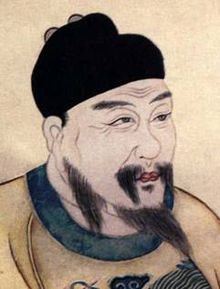Longwu Emperor
| Longwu Emperor | |||||||||||||||||
|---|---|---|---|---|---|---|---|---|---|---|---|---|---|---|---|---|---|
 |
|||||||||||||||||
| Prince of Tang (唐王) | |||||||||||||||||
| Reign | 18 July 1632 - 17 December 1632 (1st reign) 21 July - 18 August 1645 (2nd reign) |
||||||||||||||||
| Predecessor | Zhu Shuohuang, Prince Duan (as 1st reign) Zhu Yuse, Prince Min (as 2nd reign) |
||||||||||||||||
| Successor | Zhu Yuse, Prince Min (as 1st reign) Zhu Yuyue (as 2nd reign) |
||||||||||||||||
| Commendery Prince of Nanyang (南陽王) Prince of Tang lineage (唐王系) |
|||||||||||||||||
| Reign | 1644 - 21 July 1645 | ||||||||||||||||
| Predecessor | title created | ||||||||||||||||
| Successor | title repealed | ||||||||||||||||
| Emperor of Southern Ming | |||||||||||||||||
| Reign | August 1645 – October 1646 | ||||||||||||||||
| Predecessor | Hongguang | ||||||||||||||||
| Successor | Shaowu & Yongli | ||||||||||||||||
| Born | 1602 | ||||||||||||||||
| Died | October 1646 (aged 44) | ||||||||||||||||
| Spouse | Empress Xiaoyixiang | ||||||||||||||||
| Issue | Zhu Linyuan, Crown Prince Zhuangjing | ||||||||||||||||
|
|||||||||||||||||
| House | House of Zhu | ||||||||||||||||
| Father | Zhu Qisheng, Hereditary Prince of Tang | ||||||||||||||||
| Mother | Lady Mao, Hereditary Princess Consort of Tang | ||||||||||||||||
| Full name | |
|---|---|
| Zhu Yujian (朱聿鍵) | |
| Era name and dates | |
| Longwu (隆武): August 1645 – October 1646 | |
| Posthumous name | |
| 配天至道弘毅肅穆思文烈武敏仁廣孝襄皇帝 | |
| Temple name | |
|
Ming Shaozong 明紹宗 |
Zhu Yujian (Chinese: 朱聿鍵; pinyin: Zhū Yùjiàn; 1602 – 6 October 1646), the Prince of Tang, reigned as the Longwu Emperor of the Southern Ming dynasty from 18 August 1645, when he was enthroned in Fuzhou, to 6 October 1646, when he was captured and executed by a contingent of the Qing army. He was an eighth generation descendant Zhu Jing, Prince Ding of Tang, who was 23rd son of Ming founder Zhu Yuanzhang.
Before ascending to the throne he followed his father as the Prince of Tang, their fief being situated in Nanyang prefecture, in Henan province. In 1636 he was stripped of his title by the Chongzhen Emperor and put under house arrest in Fengyang. His former title was transferred to his younger brother Zhu Yumo (朱聿鏌). In 1641 the latter committed suicide when Li Zicheng invaded Nanyang. After the death of the Chongzhen Emperor 1644, his successor on the Ming throne, the Hongguang Emperor released the Prince of Tang from his arrest.
When Qing forces captured Nanjing in June 1645 he fled to Hangzhou. In August of the same year at the behest of several high officials he ascended to the Ming throne in Fuzhou, taking the reign title Longwu (隆武; pinyin: Lóngwǔ). His era name means "Plentiful and martial". After a promising start, Fujian's geographical position on the margin of the empire, cut off the heartland through several mountain ranges, as well as his lack of effective troops and the failure on part of the officialdom to find a united stance doomed the Longwu government. When Qing forces invaded Fujian in the late summer of 1646, Zheng Zhilong, the emperor's strongest ally, surrendered while his son Zheng Chenggong (the famous Koxinga) retreated to sea.
...
Wikipedia
